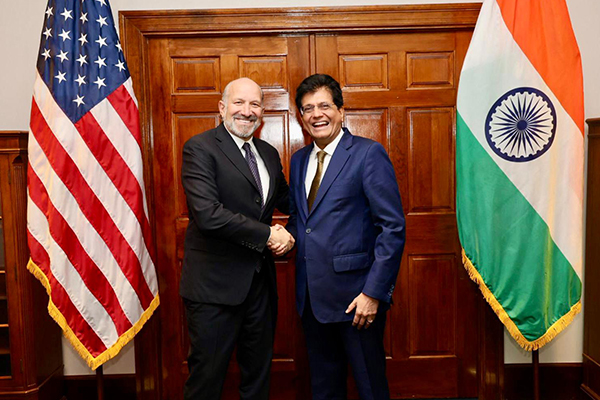In FY2025, the United States recorded a trade deficit of about $44.4 billion with India, meaning it imported far more goods and services from India than it exported.
President Donald Trump regularly highlights this gap, accusing India of unfairly benefiting from trade. Washington is using the deficit figures to push India to unilaterally lower tariffs and open its market further.
But this trade deficit narrative is misleading — and incomplete.
According to the Global Trade Research Initiative (GTRI), the U.S. quietly rakes in $80–85 billion every year from India through education, digital services, financial operations, intellectual property royalties, and arms sales.
These massive earnings don’t show up in the narrow goods trade statistics. When you factor them in, the U.S. isn’t running a deficit with India at all — it’s sitting on a $35–40 billion surplus.
This flips the script entirely. Far from being a victim in the relationship, the U.S. is a top beneficiary. For India, this means it has every reason to walk into free trade agreement negotiations with confidence, pushing back hard against inflated deficit claims and demanding fair, balanced terms that reflect the full economic relationship — not just a narrow, cherry-picked slice of the ledger.
However, if the U.S. insists on focusing solely on the trade deficit, then India should narrow the conversation strictly to tariff cuts — and firmly refuse to entertain talks on government procurement, digital trade, intellectual property, and the many other areas where U.S. firms stand to massively expand their profits inside India.
There’s no reason for India to hand over sweeping concessions in sectors that have nothing to do with balancing trade — especially when these concessions would only further boost America’s already dominant earnings from the Indian market.
US Trade Deficit With India
On February 13, 2025, Trump claimed the U.S. had a $100 billion trade deficit with India. This was incorrect — the actual figure is under $45 billion. Here are the details.
In FY2025, trade between India and the U.S. reached $186 billion as per DGCI&S Data. India exported $86.5 billion in goods to the U.S. while importing $45.3 billion, creating a goods trade surplus of $41 billion. In services, India exported an estimated $28.7 billion and imported $25.5 billion, adding a $3.2 billion surplus. Altogether, India ran a total trade surplus of about $44.4 billion with the U.S.
How US Earns From India
One of the biggest U.S. money-makers from India is its higher education sector. Indian students studying in the U.S. spend over $25 billion every year — about $15 billion on tuition and another $10 billion on living expenses.
With the average Indian student spending between $87,000 and $142,000 per year, top universities like USC, NYU, Northeastern, and Purdue are major beneficiaries, making education one of America’s biggest “exports” to India.
U.S. tech giants like Google, Meta, Amazon, Apple, and Microsoft bring in another $15–20 billion a year in sales from India’s booming digital market. These revenues come from digital ads, cloud services, app stores, software and device sales, and streaming subscriptions — most of which flow straight back to the U.S., thanks to limited local rules on data and taxation.
American banks and consulting firms — including Citibank, JPMorgan, Goldman Sachs, McKinsey, BCG, Deloitte, PwC, and KPMG — earn an estimated $10–15 billion revenue annually from their work in India’s financial sector, advising companies, managing corporate deals, and providing high-end services.
Another major source of U.S. income comes from Global Capability Centers (GCCs) run by companies like Walmart, Dell, IBM, Wells Fargo, Cisco, and Morgan Stanley in Indian tech hubs like Bengaluru and Hyderabad. These back-end offices handle global operations in tech, finance, and analytics. While most work is done in India, much of the real economic value is booked in the U.S. GCCs earn $15-20 billion revenue yearly through India operations.
The U.S. pharma firms like Pfizer, Johnson & Johnson, and Merck earn $1.5–2 billion annually through patents, drug licensing, and technology transfer. Auto companies like Ford, GM, and component suppliers earn $0.8–1.2 billion through licensing and technical services.
Hollywood and U.S. streaming platforms contribute another $1–1.5 billion through Indian box office sales, subscriptions, and content licensing, with Netflix alone estimated to spend $400–500 million a year on Indian content.
Finally, U.S. defense sales to India bring in billions more, although exact figures are often confidential.
While exact firm-level data is not publicly available, these estimates — based on broad industry trends — paint a clear picture: even as Washington pressures India to cut tariffs and open markets, America is already reaping huge, economic rewards from India.
Conclusion
As the U.S. pushes India to make one sided trade concessions, New Delhi should stand firm. The facts are clear: India is not just a passive trade partner but a major contributor to American wealth across education, technology, finance, and defense. India can and should negotiate the free trade agreement from a position of strength — rejecting hollow deficit arguments and demanding fair, balanced, and reciprocal terms.





